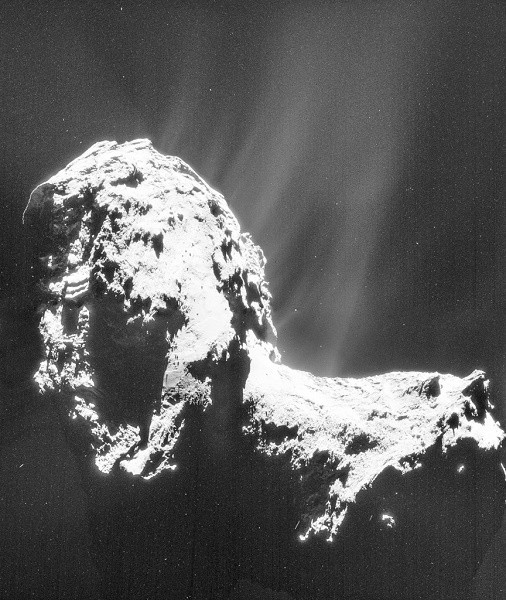By Ana Verayo, | April 11, 2016

Comet 67P's coma. Four image NAVCAM mosaic comprising images taken on 20 November.
Astronomers detected some special ice crystals known as clathrate ice on the surface of Comet 67P/Churyumov-Gerasimenko which could provide potential answers about the origins of the solar system.
Since comets are mostly made from ice, dust and other materials, astronomers have theorized if this ice formed as a highly ordered crystal or some random amorphous structure. These crystalline ices are called clathrates which have been successfully detected by mission scientists from the coma or atmosphere of comet 67P.
Like Us on Facebook
This type of ice formations possess gas inside its structure which leads to a higher degrees of order within its composition. Gas molecules are emitted during specific temperatures, where this event has been captured by astronomers upon further observation of this comet.
Since this discovery, scientists know believe that the detection of clathrate ices from the comet's coma is now suggesting this icy, dirt ball most probably formed near a region closer to the sun than first thought.
According to Adrienn Luspay-Kuti from the Southwest Research Institute, this particular phase and structure of the ice is crucial to know since it can reveal a lot about where the comet might have formed. This means that if the building blocks of comet 67P were mostly made of crystalline ices and clathrates, then this comet probably agglomerated from large chunks of ice nearer the sun. The protosolar nebula that is closer to the sun was exposed to higher temperatures including more turbulence where crystalline ices formed when the nebula cooled down.
On the other hand, those comets with amorphous structure or indefinite form would mean that these ices would have formed at a more distant region from the sun, with lower temperatures and less turbulent conditions.
Astronomers have long believed that comets are remnants from a time when the solar system was just in its infancy, providing a glimpse of the material that created planets and bodies in our solar system today.
However, since there is no way to directly obtain a sample from the ice and dust inside the core of the comet, studying the comet's coma can reveal the elements and substances inside these icy, primordial space objects.
Now, researchers confirm that data collected by the ESA's comet chaser Rosetta spacecraft, included the detection of clathrate ice structures. This new study is published in the journal, Science Advances.
-
Use of Coronavirus Pandemic Drones Raises Privacy Concerns: Drones Spread Fear, Local Officials Say

-
Coronavirus Hampers The Delivery Of Lockheed Martin F-35 Stealth Fighters For 2020

-
Instagram Speeds Up Plans to Add Account Memorialization Feature Due to COVID-19 Deaths

-
NASA: Perseverance Plans to Bring 'Mars Rock' to Earth in 2031

-
600 Dead And 3,000 In The Hospital as Iranians Believed Drinking High-Concentrations of Alcohol Can Cure The Coronavirus

-
600 Dead And 3,000 In The Hospital as Iranians Believed Drinking High-Concentrations of Alcohol Can Cure The Coronavirus

-
COVID-19: Doctors, Nurses Use Virtual Reality to Learn New Skills in Treating Coronavirus Patients







